SAIVA Inno & Launch
Led the development of data-driven features and system refinement for SAIVA to achieve a market-ready state
Spearheaded the transformation of SAIVA from a prototype into an MVP-ready product, delivering cutting-edge, data-driven features. My contributions were exclusively within Jan 2023 to May 2024.
Contents Overview
- Product Introduction
- My Role and Responsibilities
- Key Achievements
- Improved Overall Delivery Quality and Team Efficiency
- Improved System Scalability
- Gained Pilot Traction with AI innovation
- Improved Immersive VR Experience
- Improved Exhibition and Pilot Readiness
- Vision and Future Impact
📚 Product Introduction
-
Background
Sports video analysis in football uses modern technology to evaluate player and team performance, offering valuable insights that help athletes and coaches improve tactics, skills, and decision-making. Traditionally, the process involves three stages:- Data Collection – Capturing real-time or recorded match and training footage.
- Analysis – Examining player movements, tactics, and team dynamics.
- Presentation – Delivering actionable insights to coaches and players.
It is desirable to have a one-stop solution that can enhance and streamline all three stages.
-
Goal
Our goal is to develop a comprehensive, one-stop solution that enhances every stage of the sports video analysis process:- Stage 1: Data Collection Enhance the efficiency on collecting football match data.
- Stage 2: Analysis Improve the depth and effectiveness of football match analysis for better game understanding.
- Stage 3: Presentation Streamline the delivery of insights to team members for more impactful collaboration.
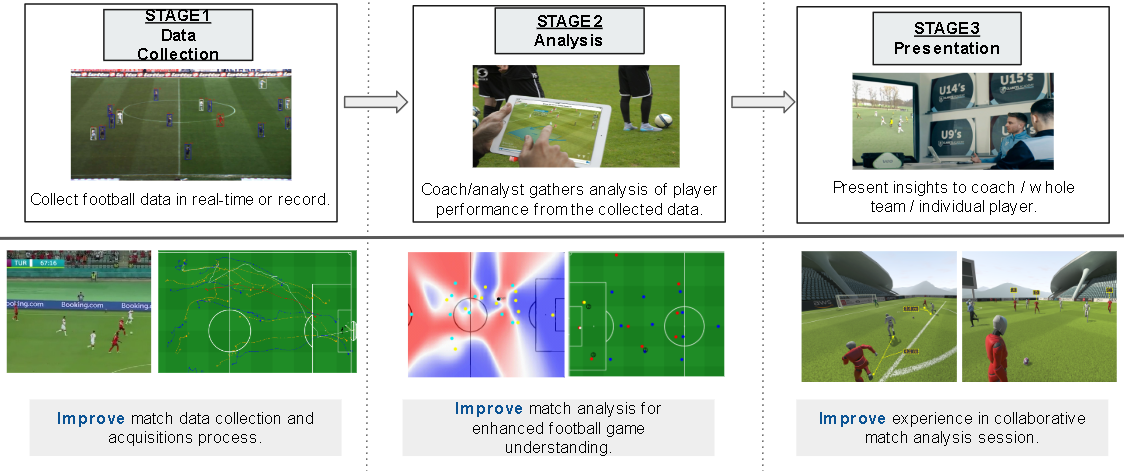 Our Goal allignments with each stages of video analysis.
Our Goal allignments with each stages of video analysis. - Solutions
Our solution is designed to enhance the entire sports video analysis workflow, from data collection to presentation. Each module aligns with a specific stage of analysis, providing the necessary functionality to gather, process, and present data-driven insights.
 Solutions allignment with each stages of video analysis.
Solutions allignment with each stages of video analysis.Stage Module Function Stage 1 - Data Collection 3rd Party Feeds Integrates external data providers that supply rich tracking/event data. 2D Editor Allows manual or semi-automated tagging of player and ball movements from video. Scouting or Broadcast Feed Uses regular match footage (low-cost input) for basic analysis, often used by budget clubs. Tracking Data Generate spatial-temporal coordinates of players and ball which are suitable for our solution. Event Data Generate discrete football events (e.g., passes, shots, tackles) which are suitable for our solution. Stage 2 - Analysis Metrics Generates quantitative performance indicators like xG, distance covered, pass completion. Recommendations Provides AI-assisted insights or suggestions for coaches based on patterns or metrics. Stage 3 - Presentation (VR) 3D Reconstruction Visualizes match scenes in 3D on VR devices to enhance understanding of positioning and space. Animation Plays dynamic VR-compatible visual sequences to explain tactical plays or behaviors. Action Suggestions Provides interactive, immersive feedback to players or coaches via VR headsets.
🌟 My Role and Responsibilities:
- Team Leadership: Led a cross-functional, multicultural team of VR, AI, and Fullstack engineers, both remote and onsite.
- Product Strategy: Collaborated with stakeholders to translate customer insights into actionable features.
- Technical Architecture: Made key decisions on system architecture, focusing on scalability, reliability, and monitoring.
- Obstacle Remover: Secured necessary resources, including contractors and potential partners, to ensure project progress.
- Delivery Manager: Leveraged an Agile framework with a strong emphasis on documentation, ensure high-quality delivery.
- Hands-on Developer: Initially led feature implementation, and later focused on filling gaps as needed.
💡 Key Achievements:
-
📈 Improved Overall Delivery Quality and Team Efficiency
Problems- The previous team lacked proper documentation, making it difficult to scale the project or onboard new developers.
- The project involved continuous feature discovery, requiring flexibility to accommodate changes and rework efficiently.
Solutions
To address the challenges of a lack of documentation and the need for flexibility in the project, we implemented the following solutions:- Documentation Overhaul: Audit existing documentation, code comments, and verbal handovers to establish a documentation-first culture using Confluence, ensuring clarity and traceability.
- Agile Implementation: Adopt an Agile approach using JIRA for sprint planning and backlog grooming, enabling rapid adaptation to feature changes while ensuring accountability and structure.
My Contributions:- Led the documentation overhaul, creating clear, accessible, and traceable resources for the development team.
- Guided the adoption of an Agile workflow, setting up JIRA for efficient sprint planning and backlog management.
🔗 I shared a breakdown of the tools, workflows, and personal strategies I used to bring structure and adaptability to this project [in this link]. -
📈 Improved System Scalability
Problems- The legacy backend was a monolith, written without a formal framework and heavily dependent on personalized coding styles. While functional, it was difficult to maintain, test, or scale.
- Video analysis tasks were compute-heavy and caused latency. In its original state, the system could only support around 2 concurrent users per instance, creating a bottleneck for any live deployment.
Solutions
To address the challenges posed by the legacy implementation, we undertook a comprehensive architectural overhaul, focusing on:- Migration to a cloud-native environment: Enabled scalability and high availability, supporting dynamic resource allocation.
- Implementation of event-driven architecture: Improved system reliability and fault tolerance by decoupling components and optimizing communication.
- Dockerization and enabling horizontal scaling: Removed concurrency bottlenecks, allowing the platform to support more concurrent users and enhance performance.
My Contribution:- Led the architectural migration of the platform to a cloud-native environment, overseeing the use of container orchestration and cloud services.
- Designed and guided the implementation of an event-driven communication system to improve system reliability and fault tolerance.
- Redesigned, decoupled, and dockerized the system to enable dynamic horizontal scaling, removing prior concurrency bottlenecks.
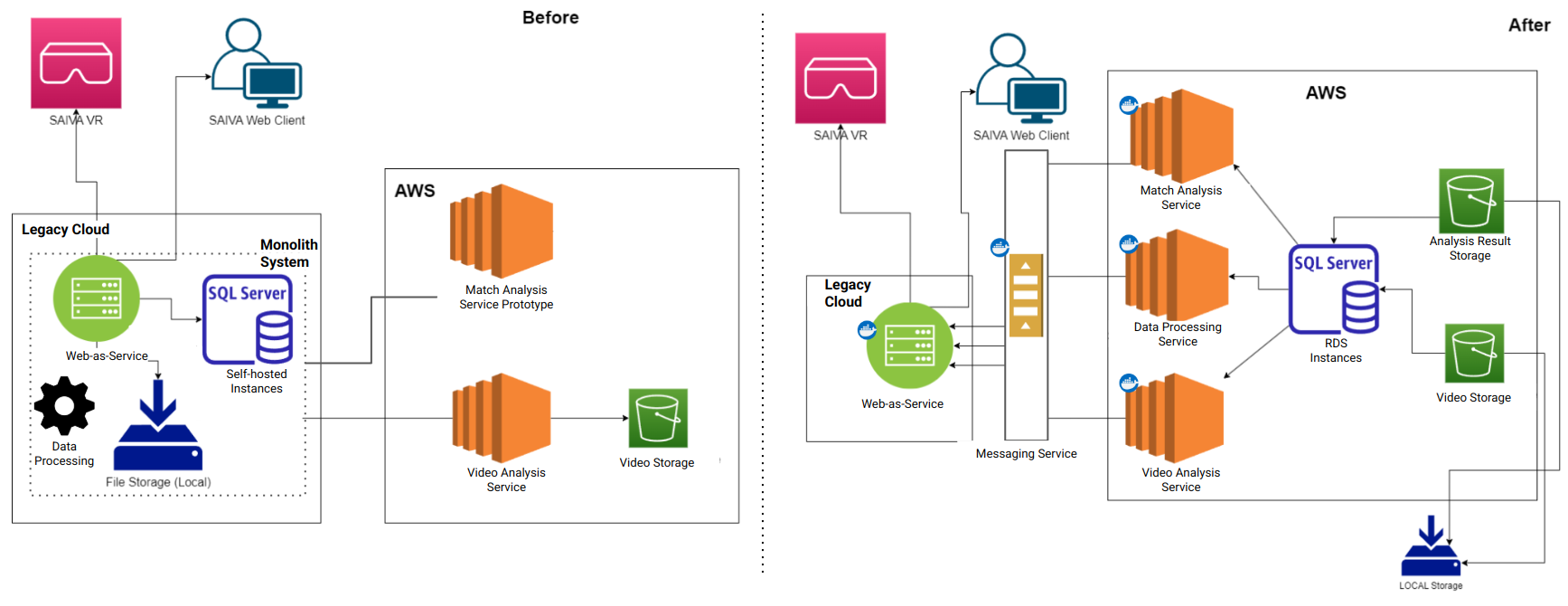 Scuffed before-after architecture showing service migration, decoupling, containerization.
Scuffed before-after architecture showing service migration, decoupling, containerization. -
📈 Gained pilot traction with AI innovation
Background- Our stakeholders recognized the value in strengthening our brand's position as an AI-driven solution.
- We identified a gap in the market where most solutions focus on automating Stage 1 (Data Collection) of video analysis, while offering limited capabilities in Stage 2 (Analysis).
- Our goal is to attract pilot interest by offering a comprehensive solution that addresses the need of advance match analysis.
SolutionsInspired by the paper Game Plan: What AI Can Do for Football, and What Football Can Do for AI and the statement of " Successful passes significantly contribute to scoring goals ", reinforces our belief that any enhancement or assistance in this area will have a profound impact on team performance. We formulate the following feature:
- Pass Recommendation: Leverages advanced football metrics and positional data to provide personalized decision-making suggestions.
- Pass Assessment: Analyzes pre- and post-pass events to deliver a clear, contextual understanding of pitch dynamics in a human-readable format.
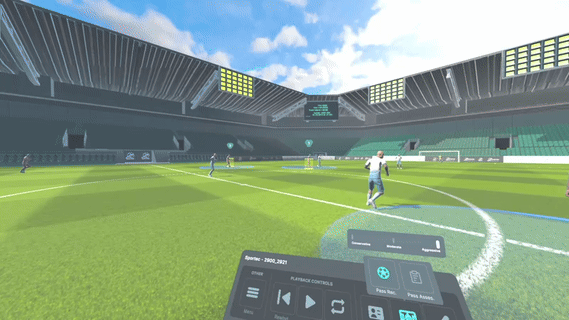
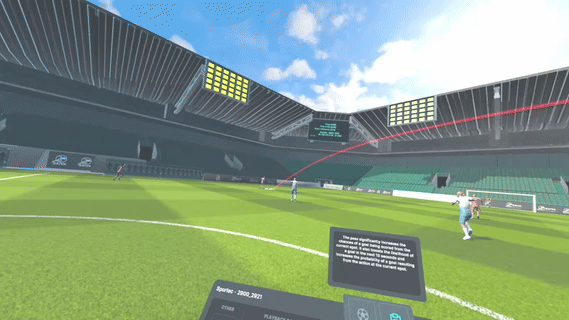 Snippets of how Pass Recommendation (Left) & Pass Assesment (Right) feature in action.
Snippets of how Pass Recommendation (Left) & Pass Assesment (Right) feature in action.This effort helped us retain our current pilot project, gain valuable signals, and ultimately secure commitments for an intensive pilot program.
My Contributions:- Led algorithm design from research to deployment. Initiated core logic, directed literature review and evaluation method selection, and guided iterative refinements by the team.
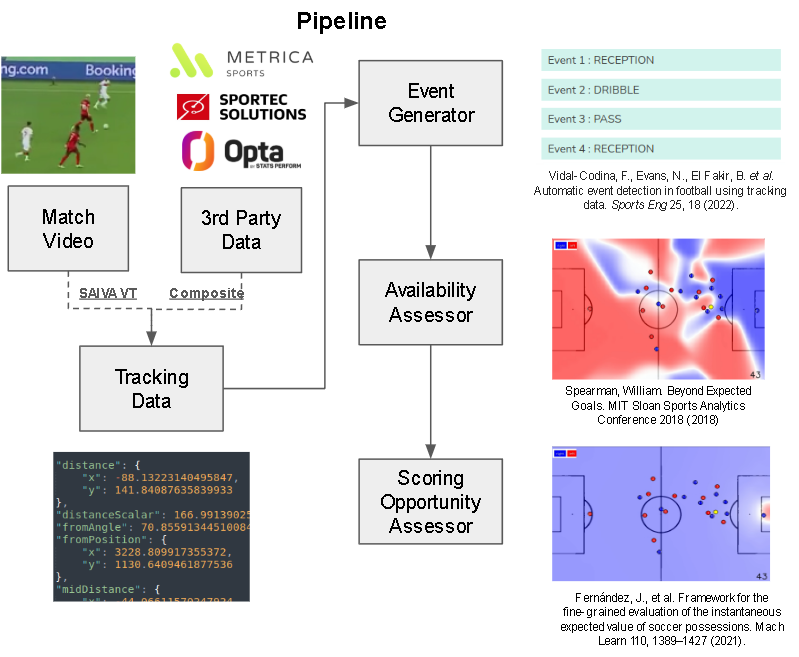
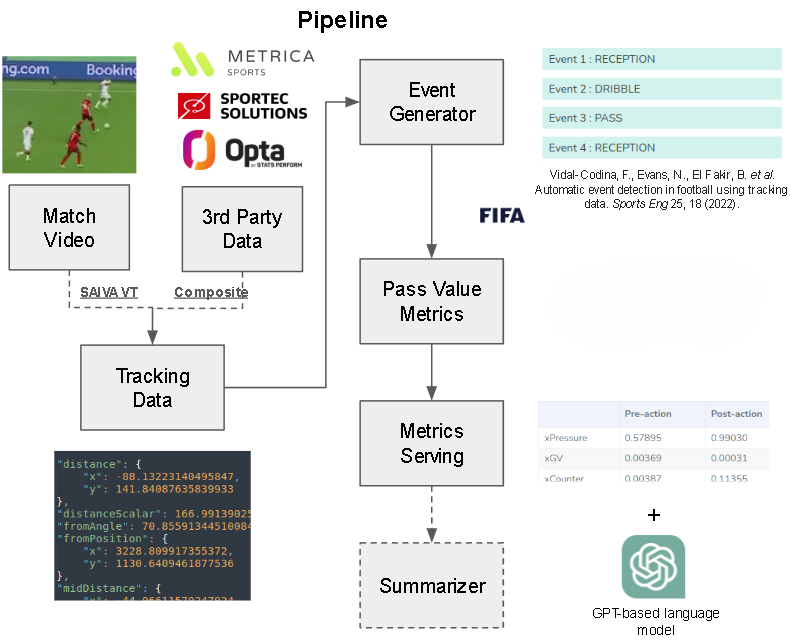 High-level system architecture and workflow of the Pass Recommendation (Left) & Pass Assesment (Right) feature.
High-level system architecture and workflow of the Pass Recommendation (Left) & Pass Assesment (Right) feature. - Built a proof-of-concept to showcase feasibility and guide feature development.
 This is what the first POC of the Pass Recommendation feature looked like.
This is what the first POC of the Pass Recommendation feature looked like. This is what the refined, higher-fidelity iteration of the POC looked like.
This is what the refined, higher-fidelity iteration of the POC looked like. - Drove validation efforts by setting up feedback loops with users and testers. Learn more about my validation approach [in this link].
- Led end-to-end development and integration of the feature into VR, leveraging Figma to translate design concepts into developer-ready specifications.
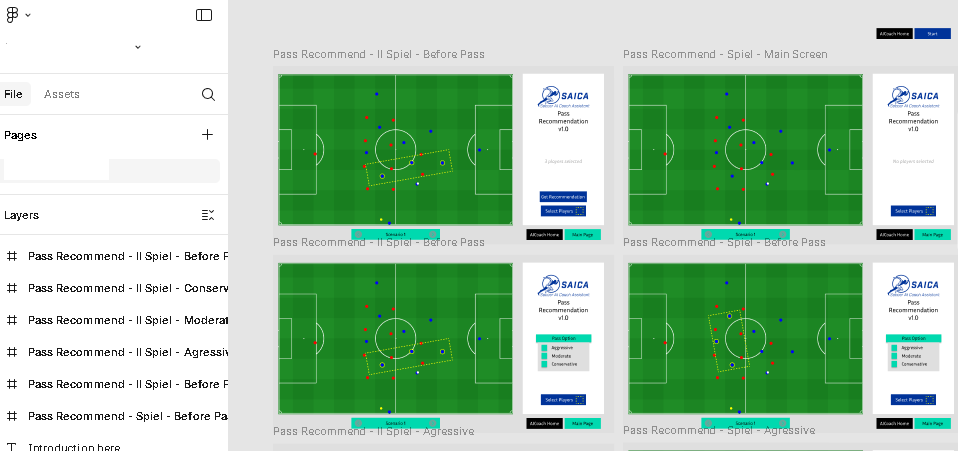 Snippets of our Figma workspace to create reference for feature interaction logic.
Snippets of our Figma workspace to create reference for feature interaction logic.
-
📈 Improved Immersive VR Experience
Problem- Despite incorporating all pilot feedback, the VR module still felt like a prototype to users.
- Internal limitations prevented us from developing high-quality VR assets in-house.
Solution- Identified, benchmarked, and selected a third-party vendor that met our quality standards and budget constraints.
- Ensured the vendor’s work aligned with our system architecture and immersive experience goals.
My Contribution- Managed third-party coordination and integrated their assets into our system, ensuring alignment with both technical and experiential requirements.
 Organizing and prioritizing features to ensure alignment with project goals, user needs, and business objectives.
Organizing and prioritizing features to ensure alignment with project goals, user needs, and business objectives.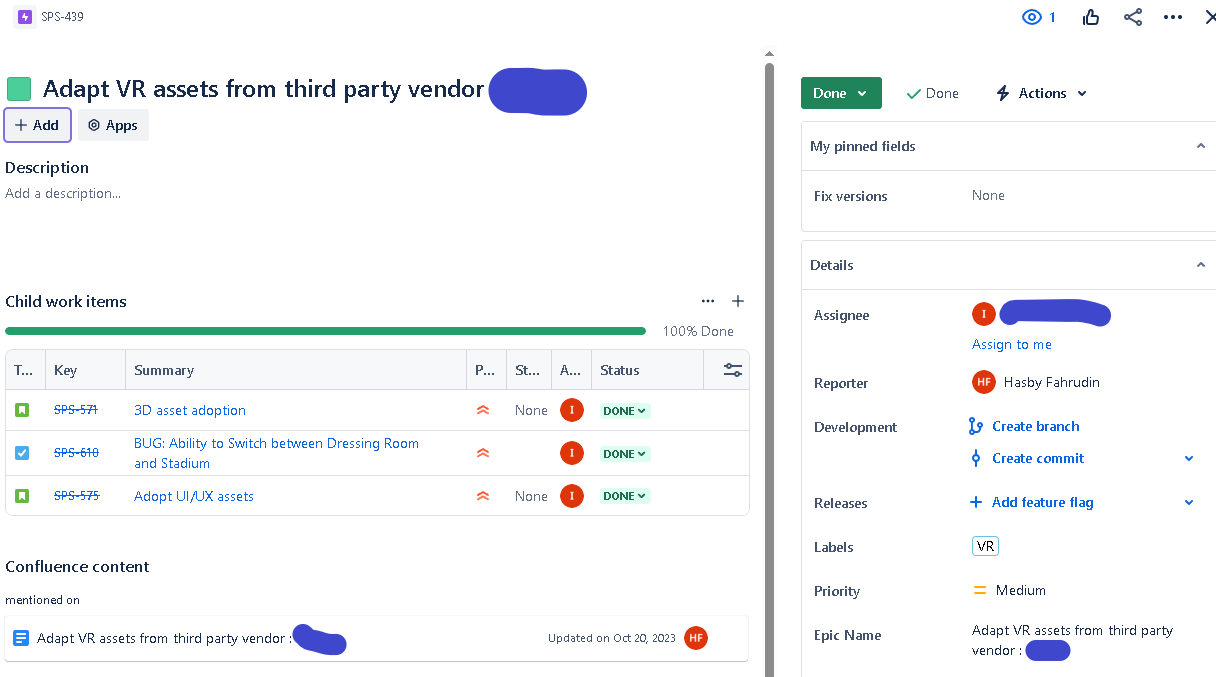 Managing JIRA tasks for seamless coordination with a third-party vendor to enhance immersive VR asset integration.
Managing JIRA tasks for seamless coordination with a third-party vendor to enhance immersive VR asset integration.
-
🚀 Improved Exhibition and Pilot Readiness
Problem:- Stakeholders saw the trade show and pilot project as key platforms to signal product viability.
- In response, we needed to prepare comprehensive product introduction and exhibition materials, but lacked dedicated design expertise to create professional visuals for the event.
- Given the nature of the trade show, we had to find innovative ways to present our product in a compelling and format-appropriate manner.
Solutions:- Secured resources and managed them effectively to ensure deliverables met the requirements.
- Creating materials and provided accurate references when outsourcing was necessary.
- Developed a demo version focused on gamifying our features, ensuring user engagement during short trial sessions while effectively showcasing the product's capabilities.
My Contributions:- Led the effort to obtain and manage design resources, working closely with the team.
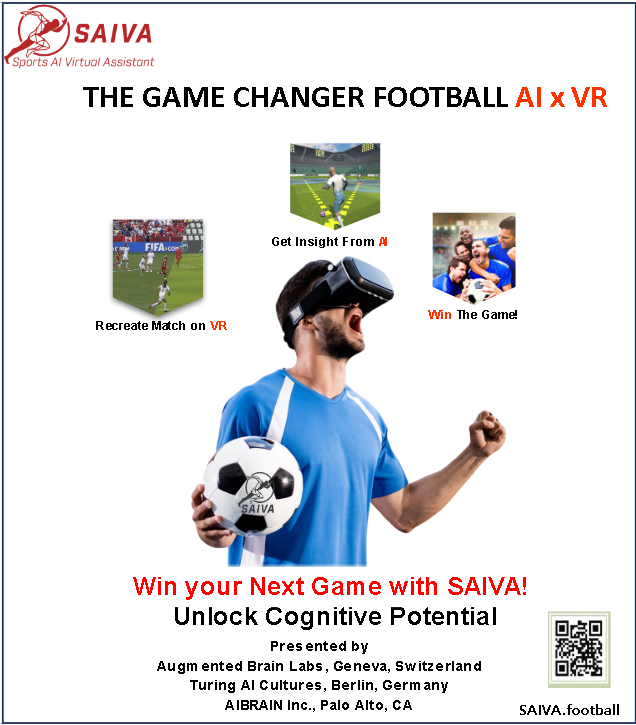
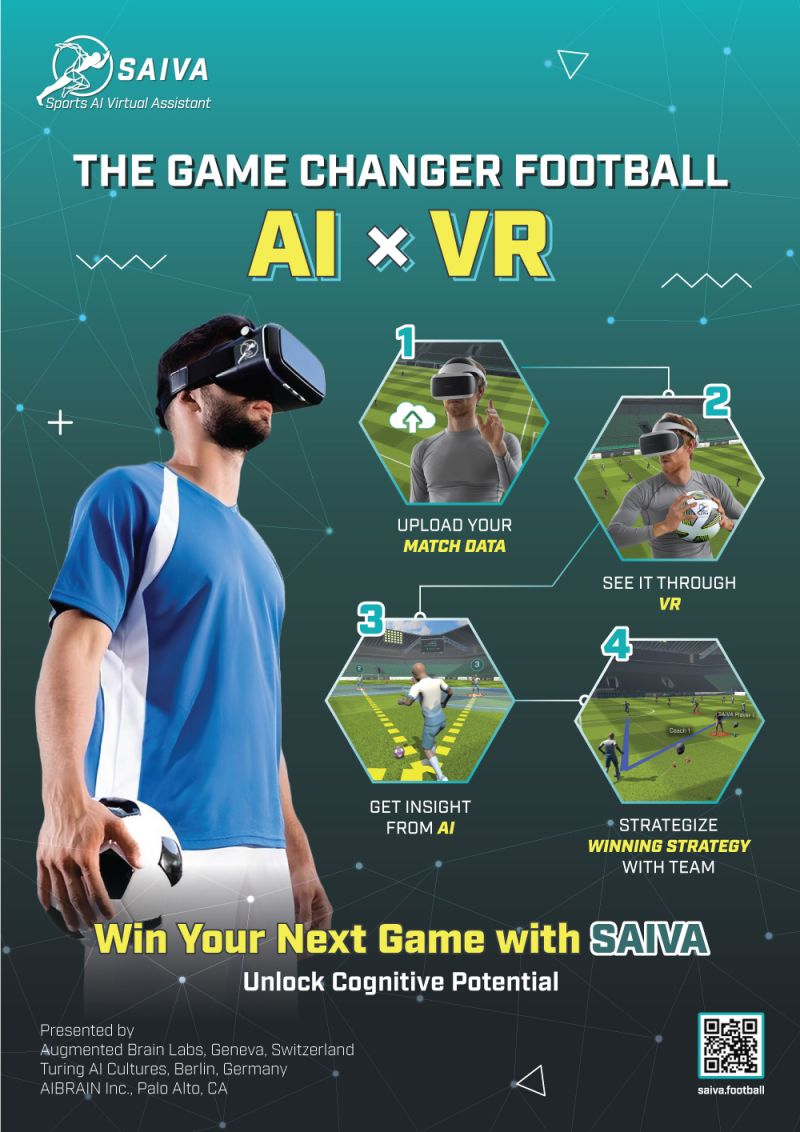 Example of design evolving from my draft (left) to final version (right) through iterations with a designer.
Example of design evolving from my draft (left) to final version (right) through iterations with a designer. - Spearheaded the creation and implementation of a gamified demo to enhance exhibition engagement.
- Benchmarked competitors and represented our product to maximize event impact.
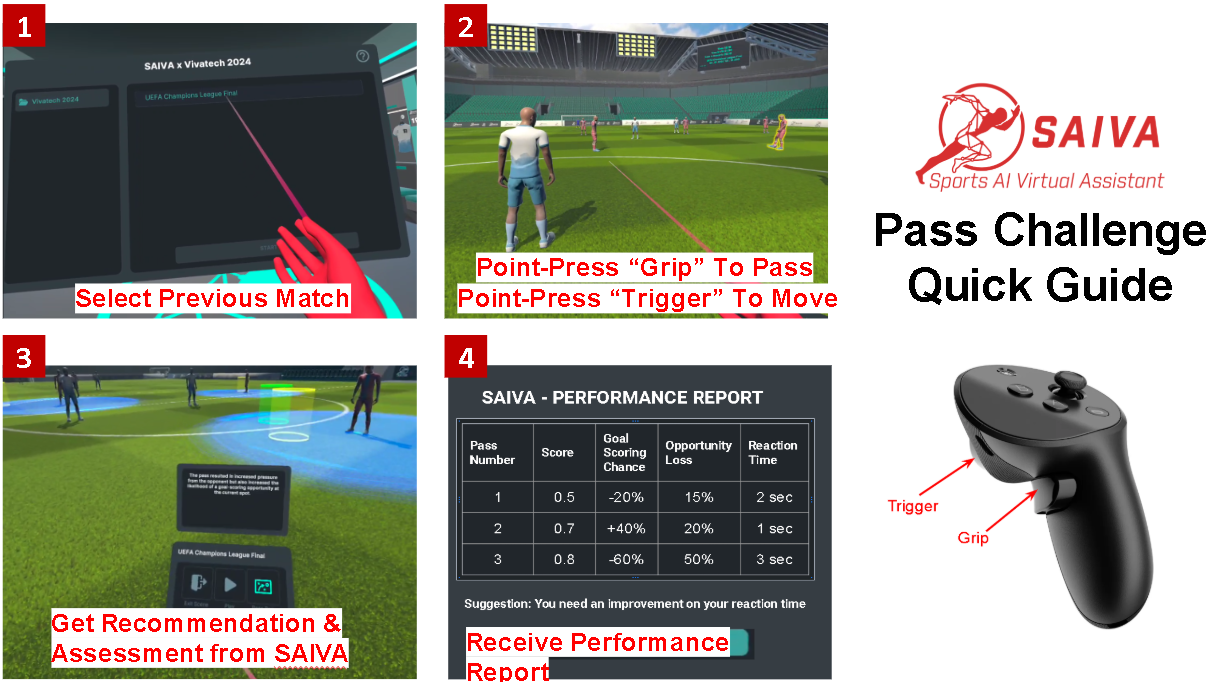 Proposed User Experience of Demo feature.
Proposed User Experience of Demo feature.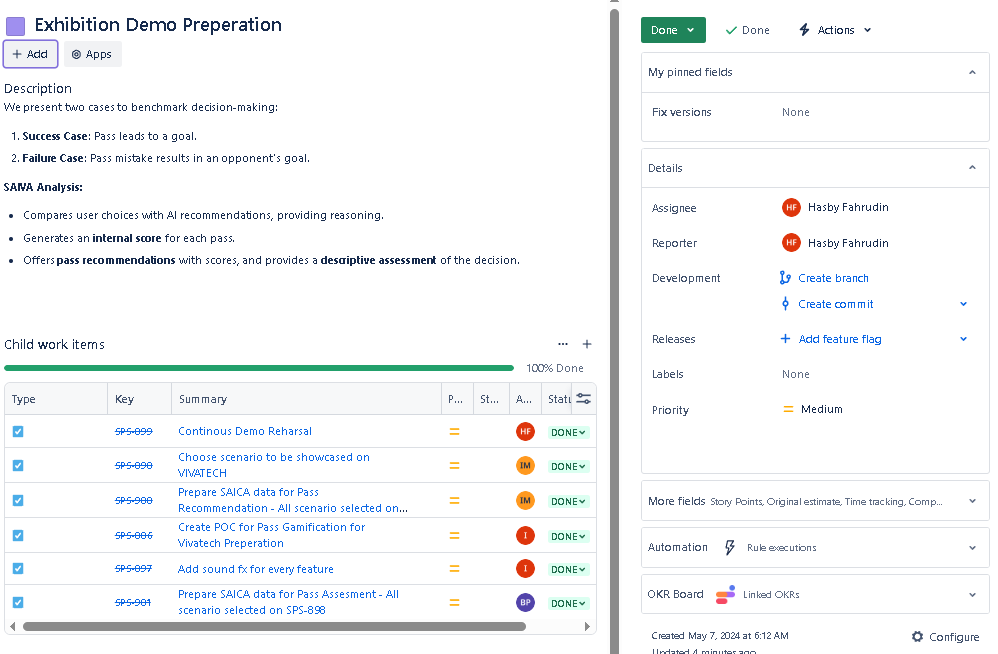 I led the JIRA epic related to preparation for the demo exhibition.
I led the JIRA epic related to preparation for the demo exhibition.Items Explanation Exhibitor Name The name of the company or exhibitor presenting at the event. Booth Traffic The level of foot traffic at the exhibitor's booth (High/Medium/Low). Social Media Engagement The level of engagement the exhibitor receives on social media (High/Medium/Low). Booth Presentation The rating of the overall booth design and presentation (1-5 scale). Interaction w/ Attendees The level of interaction between booth staff and event attendees (1-5 scale). Brand Visibility The effectiveness of the exhibitor's branding visibility at the event (1-5 scale). Demo Quality The quality and effectiveness of the exhibitor's product demo (1-5 scale). Picture A link to a picture of the booth or demonstration. Our design of a benchmark table to evaluate the performance of other participants.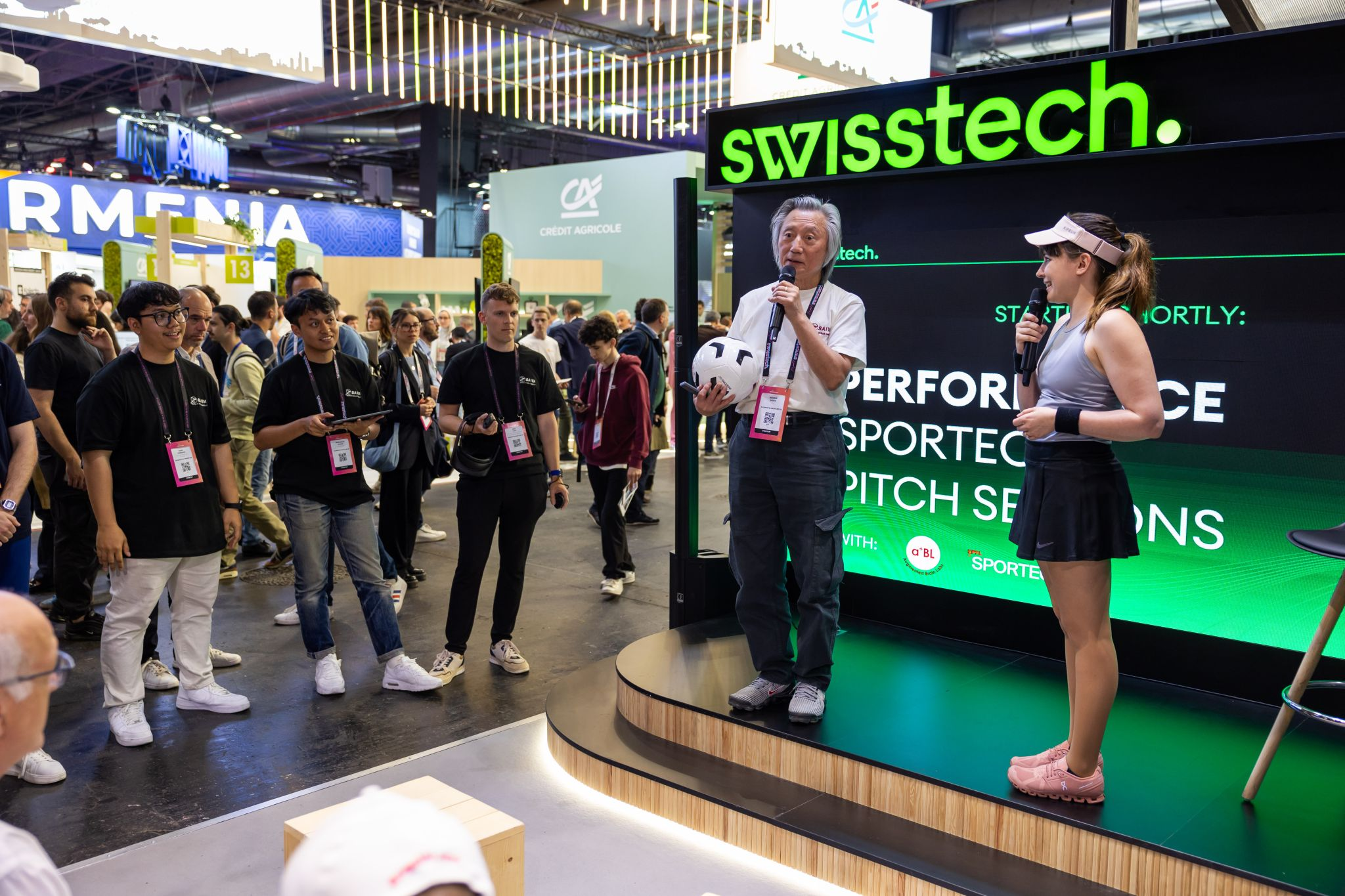 Photo of me and my colleagues during the product presentation, ensuring the demo session proceeded without issues.
Photo of me and my colleagues during the product presentation, ensuring the demo session proceeded without issues.
🔮 Vision and Future Impact:
Beyond technical experience, SAIVA provided valuable lessons in leading a product team, embracing best practices, becoming a proactive listener to feedback, and gaining deeper exposure to a fast-paced, startup-driven environment. I did my part in bringing the product to its MVP state, which an intellectually fulfilling journey. As the project matured, it became clear that my expertise was ready to be applied to new challenges.